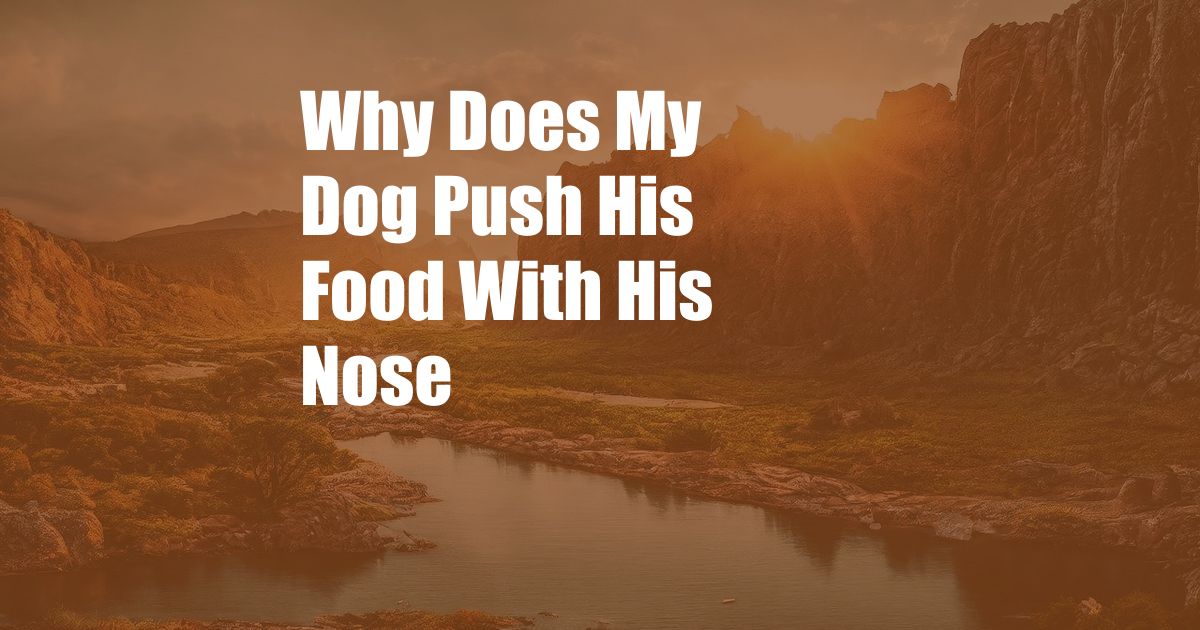
Why Does My Dog Push His Food With His Nose?
As a dog owner, it’s common to observe peculiar behaviors exhibited by our furry friends. Among these, one that often puzzles us is why dogs push their food with their nose. This intriguing action has been the subject of much debate and curiosity, and understanding its underlying reasons can shed light on our dog’s instincts and behavior.
The Role of Instincts
Dogs are descendants of wolves, and as such, they retain certain instincts that guided their ancestors in the wild. One such instinct is the “pushing” or “nosing” behavior, which stems from the way wolves would cover their food with dirt or leaves to hide it from scavengers. This behavior ensures that their food remains protected and secure for future consumption.
Hunting Instinct
Another theory suggests that dogs push their food with their nose as a remnant of their hunting instincts. In the wild, wolves often bury their prey to keep it safe and away from potential predators while they rest or gather resources. By pushing their food away, dogs may be exhibiting a similar behavior, ensuring that their meal remains untouched and available for later consumption.
Food Preference and Texture
The texture and taste of the food can also influence a dog’s tendency to push it with its nose. Some dogs may dislike the texture of certain foods, such as mushy or crumbly kibble, and pushing the food away allows them to select the pieces they prefer. Additionally, dogs may push away food that has an unfamiliar or unpleasant odor, demonstrating their sensitivity to scents and flavors.
Dental Problems
In some cases, a dog’s tendency to push food with its nose may be a symptom of an underlying dental issue. Pain or discomfort in the gums or teeth can make it painful for dogs to bite or chew, causing them to push their food away with their nose as a way to avoid discomfort. If this behavior is accompanied by any other symptoms such as excessive drooling, reluctance to eat, or bad breath, it’s essential to schedule an appointment with a veterinarian to rule out any potential dental problems.
Playful Behavior
It’s important to note that sometimes, dogs push their food with their nose simply as a playful behavior. They may enjoy the sensation of pushing the food around and creating movement or even using it as a form of engagement with their owners. Observing the dog’s overall body language and demeanor can help determine if the food-pushing behavior is playful rather than indicative of a more significant issue.
Tips to Address the Issue
If you’re concerned about your dog’s food-pushing behavior, here are a few tips to consider:
- Switch to a different food: Experiment with different types and textures of food to see if the dog prefers a specific one.
- Check for dental problems: Schedule regular dental checkups to rule out any underlying dental issues that may be causing pain or discomfort.
- Provide a comfortable eating environment: Ensure that your dog has a quiet and stress-free place to eat, away from distractions or potential threats.
- Engage in interactive feeding: Try using puzzle feeders or engaging in feeding games to stimulate your dog’s natural foraging instincts and make mealtime more enjoyable.
FAQs on Dog Food Pushing Behavior
Q: Is it normal for dogs to push their food with their nose?
A: Yes, it’s a common behavior that can be influenced by instincts, hunting behaviors, food preferences, dental issues, or playful tendencies.
Q: When should I be concerned about my dog’s food-pushing behavior?
A: If the behavior is accompanied by other symptoms such as excessive drooling, reluctance to eat, or bad breath, it may indicate an underlying dental issue.
Q: How can I stop my dog from pushing his food with his nose?
A: Experiment with different food types, check for dental problems, provide a comfortable and stress-free eating environment, and consider using puzzle feeders or feeding games to stimulate their natural instincts.
Conclusion
Understanding why your dog pushes his food with his nose can provide valuable insights into his instincts, preferences, and well-being. By observing your dog’s behavior, considering the potential underlying causes, and implementing appropriate tips or seeking veterinary advice if necessary, you can help ensure that your furry friend enjoys a healthy and happy eating experience.
Are you interested in learning more about dog behavior and training? Let us know in the comments below!